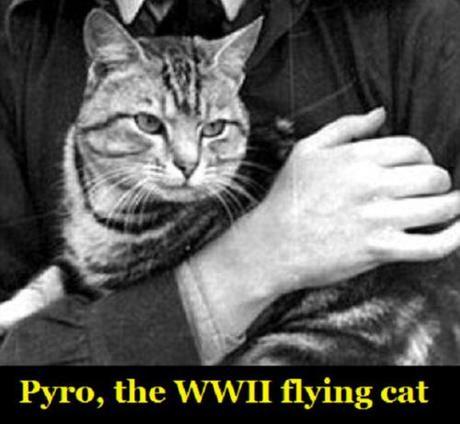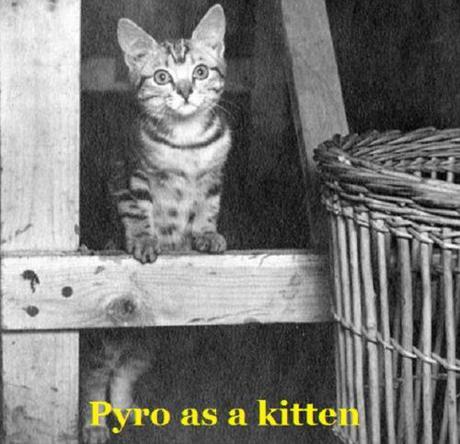In the United Kingdom, Remembrance Sunday is held on the second Sunday in November “to commemorate the contribution of British and Commonwealth military and civilian servicemen and women in the two World Wars and later conflicts.”
On Remembrance Sunday, November 13, 2011, a tabby cat named Pyro received a special posthumous commendation for his bravery during the Second World War, from the People’s Dispensary for Sick Animals charity.

As recounted by The Daily Mail, Pyro was at the side of young crews flying on experimental bomb tests above the Atlantic in the Second World War, kept inside the flight jackets of crew members while flying at altitudes of 20,000ft and even flew on the legendary “bouncing bomb” tests.
Pyro even protected the hands of his owner Bob Bird from frostbite by keeping them warm when the plane they were in crash-landed in the sea.
Bob’s son Robin, 64, said: “We are really very proud of Pyro. He was the only flying cat in the Second World War – and any other war as far as we know. The crews believed that Pyro kept them safe during the dangerous experimental flights over the Atlantic. Those missions were very dangerous and a lot of crews died so they were very superstitious and Pyro was very important for morale.”
In 1942, Bob Bird was a 22-year-old Liverpool photographer who was dispatched to the Marine Aircraft Experimental Establishment (MAEE) base in Helensburgh, Scotland, to document experimental weapons being tested to destroy German U-boats.
There, he found a tabby kitten searching for a warm place to stay in his dark room.

When the kitten accidentally trapped his tail in a sliding door and had to taken to the base medical officer for treatment, Bird decided to adopt the kitten and named him Pyro, after the photographic developing chemical pyrocatechol.
Pyro used to hang around the base waiting for Bird to return from missions. When Bird noticed Pyro was miserable when left alone, Bird began carrying the kitten in his flying jacket. His son, Robin, explained, “Pyro used to love to fly. He wasn’t scared at all. My mother told me that Bob would whistle when he was going flying and Pyro would come running.”
Pyro earned his wings one winter’s day in early 1943 when, at 20,000ft, ice covered the plane Bob Bird was flying in. The photographer took off his glove to change a lens and got severe frostbite in his fingers. So he used the heat from Pyro in his flying jacket to warm his hands. Pyro stayed in position even after the plane had to make a crash-landing in the sea off the west coast of Scotland, when the pilot was rendered blind by severe frostbite.
Bird spent two weeks in hospital recovering and was later told by doctors the cat had saved his fingers.
In 1945, Bird was transferred to RAF Beaulieu in Hampshire. He took Pyro with him but one day, he returned to base to find Pyro, who was fully grown and too big to fly, had been hit by a truck and killed.
Robin Bird said, “My dad used to talk about Pyro all the time. He had a really strong affection for him and he was devastated when he got killed. Judging from my dad’s stories Pyro deserved to be honored which is why I nominated him for this [posthumous] award. We have also set up a shrine to Pyro at the Fort Perch Rock aviation museum in the Wirral.”
~Eowyn

